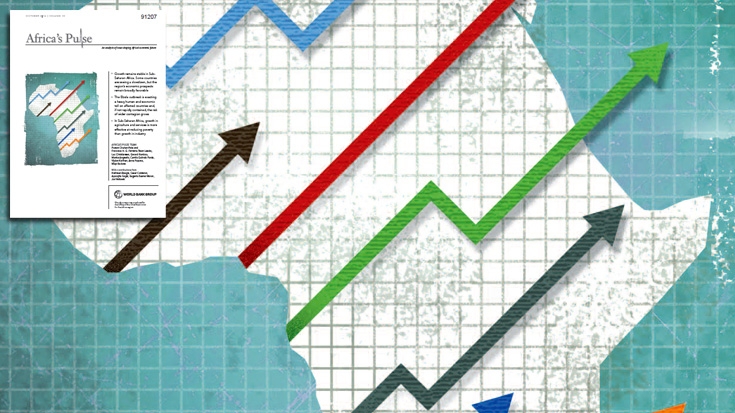WASHINGTON, October 7, 2014 – Despite a weaker than expected global economy, with a number of major countries showing mixed performances, growth prospects for Africa remain positive and the region’s GDP growth is projected to rise to 5.2% in 2015-16 and 5.3% in 2017.
These latest figures are outlined in the World Bank’s new Africa’s Pulse, the twice-yearly analysis of economic trends and the latest data on the continent.
According to Africa’s Pulse, growth in the region is supported by strong public investment in infrastructure, increased agricultural production, and a buoyant services sector. Overall, Sub-Saharan Africa is forecast to remain one of the fastest growing regions.
Across the region, there has been substantial investment in infrastructure, including in ports, electricity capacity, and transportation. Several countries have also seen a strong recovery in the agriculture sector in 2014 and expect it to continue in 2015. The expansion of the services sector led by transport, telecommunications, financial services and tourism is also spearheading overall economic growth in a number of countries.
Although the region continues to grow faster than many economies around the world, Sub-Saharan Africa still lags behind the rest of the world in making progress toward the Millennium Development Goals (MDGs). For example, while the target of halving the proportion of people whose income falls below $1.25 a day has been met globally, the region has reached only 35% of that goal.
Africa’s Pulse also notes that West Africa’s Ebola outbreak will severely disrupt activity in key economic sectors in Guinea, Liberia, and Sierra Leone and slow growth in these countries in 2014. Economic spillovers could also affect neighboring countries.
In a special study of economic transformation and poverty reduction in Africa, the report finds that the region’s economies are transforming but not in ways that were expected. The region is largely bypassing industrialization as a major driver of growth and jobs, and the extent of reallocation of labor to high-productivity, nontraditional activities has been limited. This pattern of growth and transformation has implications for poverty reduction. In Africa, growth in agriculture and services has been more poverty reducing than growth in industry. In the rest of the world, by contrast, industry and services have a larger impact on reducing poverty.
Looking Ahead
Investments and policies to promote growth in rural economies emerge as critical for accelerating poverty reduction in Africa. Movement from rural areas to Africa’s growing cities is generating substantial domestic demand and has the potential to help spread the benefits of growth to more people.
But, designing policies that raise incomes for the poor is a key challenge and boosting agricultural productivity alone will not suffice. Investments in rural public goods (e.g. education, health, rural roads, electricity and ICT) and services (including in small towns) will be important to boost rural economies and facilitate transformational growth.
Finally, while manufacturing may not provide a solution, the report calls for Sub-Saharan Africa to expand its manufacturing base, especially by boosting the business climate, lowering transport cost, providing cheaper and more reliable power, and building a more educated labor force.
The Report’s Key Messages:
- Global growth has been weak, with divergent trends in high-income countries, and below long-run growth levels in developing countries.
- Sub-Saharan Africa is growing at a moderate pace, reflecting in part a slowdown in some of the region’s large economies. Public infrastructure investment, a rebound in agriculture, and a buoyant services sector are key drivers of growth in the region.
- Prospects for the region remain favorable, despite headwinds. External risks of higher global financial market volatility and lower growth in emerging market economies weigh on the downside. In several Sub-Saharan African countries, large budgetary imbalances are a source of vulnerability to exogenous shocks and underscore the need for rebuilding fiscal buffers in these countries.
- A key risk on the domestic side is a contagion of the Ebola outbreak. Without a scale-up of effective interventions, growth would slow markedly not only in the core countries (Guinea, Liberia, and Sierra Leone), but also in the sub-region as transportation, cross-border trade, and supply chains are severely disrupted.
- Sub-Saharan Africa is lagging sharply in achieving the Millennium Development Goals (MDGs); for example, the region has achieved only a third of the poverty target of halving the proportion of people living under $1.25 a day, while globally this target has already been met. In addition, there is considerable variation across countries in how much progress is being made on the MDGs.
- The region’s pattern of growth and economic transformation has implications for poverty reduction. In Sub-Saharan Africa, growth in agriculture and services has been more effective at reducing poverty than growth in industry.
- Structural transformation has a role to play in accelerating poverty reduction in Sub-Saharan Africa. Increasing agricultural productivity will be critical to fostering structural transformation. Boosting rural income diversification can facilitate this transformation, as well. Investments in rural public goods and services (for example, education, health, rural roads, electricity and ICT), including in small towns, will be conducive to lifting productivity in the rural economy.
- Although Sub-Saharan Africa’s pattern of growth has largely bypassed manufacturing, growing the region’s manufacturing base, especially by improving its fundamentals—lower transport cost, cheaper and more reliable power, and a more educated labor force—will benefit all sectors.

